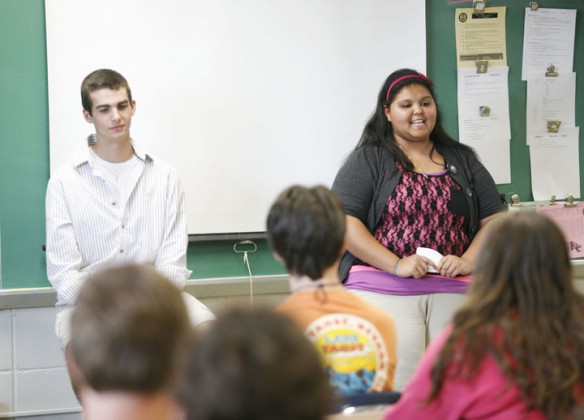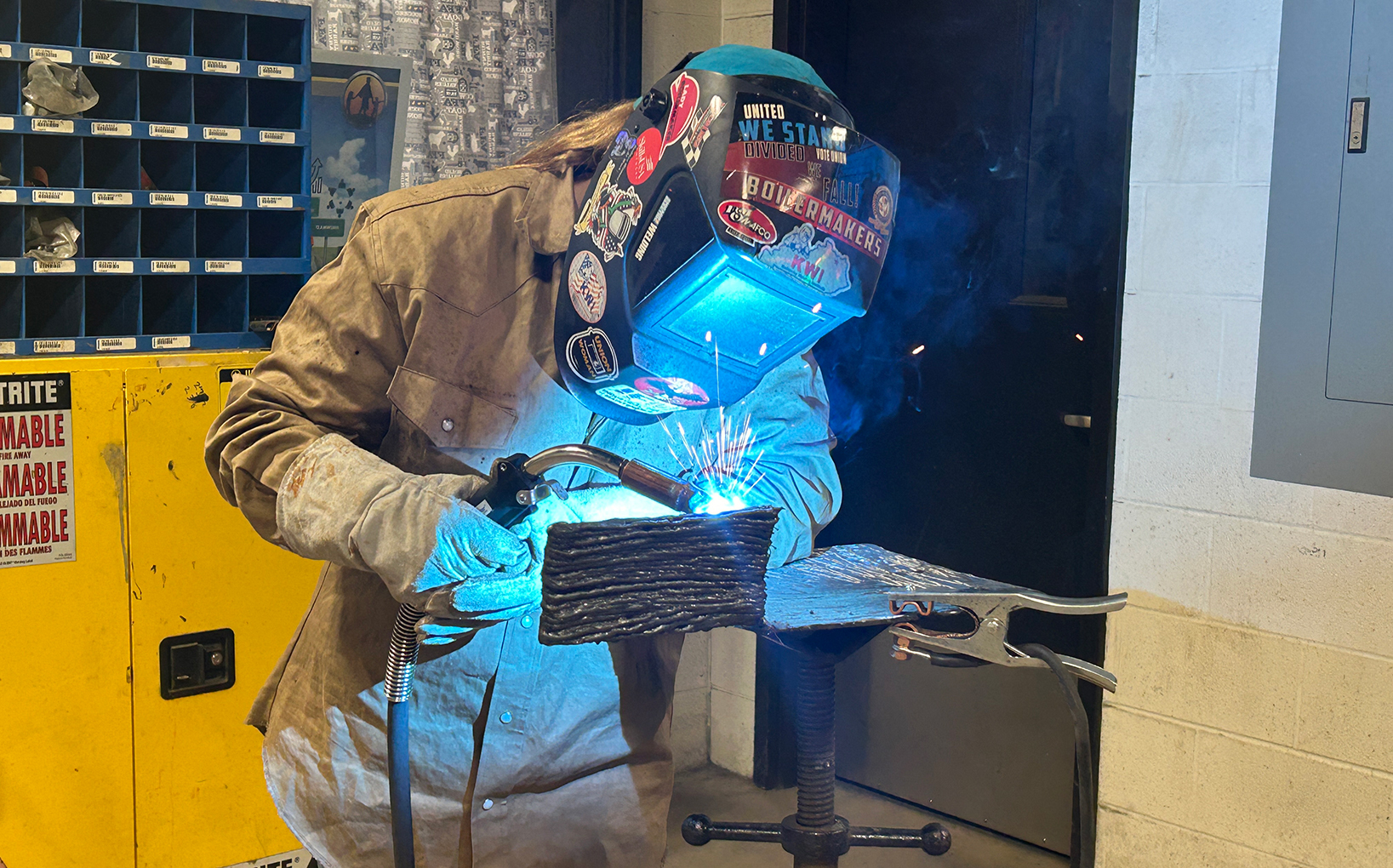
Sophomore Tiara Brand, right, gives a humorous and informative speech about freshman Mason Stamm, left, for her first speech of the year during Steve Meadows Speech 1 class at Danville High School (Danville Ind.). Photo by Amy Wallot, Aug. 16, 2011
By Susan Riddell
Susan.riddell@education.ky.gov
For Steve Meadows, an English teacher at Danville High School (Danville Independent), the emphasis on speaking and listening standards in the Kentucky Core Academic Standards makes perfect sense.
“For me personally, it’s an exciting shift in emphasis to include what I’ve always loved best – speech and speaking – as part of the general curriculum,” said Meadows, who has been an educator for more than 20 years. “I’m a great believer that our job in language arts is to empower students to be able to communicate clearly for the rest of their lives.
“Students will communicate more through speaking and listening in real life than they will through reading and writing, so including the full range of literacy in the standards and in our coursework makes sense to me.”
Meadows coaches the Danville High forensics/speech team that won the 2011 Kentucky Educational Speech and Drama Association (KESDA) state title.
“The new speaking and listening standards are simply documentation of what we in language arts have known for years – that part of full literacy includes being able to communicate orally, to understand what’s being said, to use rhetoric and research and to discuss thoughtfully,” he said.
Kathy Keinath, a 3rd-grade teacher at James Lane Allen Elementary (Fayette County), said the new state standards are more intricate, but the bigger picture is preparing students for the real world.
“These kids can go anywhere in terms of college and more,” Keinath said. “We have to account for that now, and the speaking and listening standards do that. We show what we know all the time through writing, but sometimes we can’t even say what we know.”
Renee Boss, academic core branch manager with the Kentucky Department of Education’s Division of Program Standards, said since speaking and listening have not been assessed on the state level, schools and districts sometimes pay less attention to these important standards.
“Although the ELA (English/language arts) standards are divided into reading, writing, speaking and listening, and language strands for conceptual clarity, the standards present an integrated model of literacy,” said Boss, whose focus is as an English/language arts leadership network facilitator. “Research supports the idea that for literacy to improve, speaking and listening must accompany reading and writing.”
The speaking and listening standards are divided into two main clusters: comprehension and collaboration, and presentation of knowledge and ideas. “I like the emphasis on the two clusters. I also like the connection between class discussion and improved understanding, and comprehension of text,” Boss said.
Teachers need to know speaking and listening can improve reading comprehension, and these standards will be assessed at the classroom and/or school/district level, she said.
“Teachers are concerned about having the appropriate resources, and knowing how to teach the speaking and listening standards effectively,” Boss said. “Teaching standards effectively also alleviates the pressure of assessment (at the state level or higher).”
Meadows agreed.
“Many of the new standards can be evaluated with end-of-course exams on paper and online, but the speaking and listening standards cannot be evaluated this way (with the possible exception of some questions about rhetoric and research),” he said. “If Kentucky is to fully implement accountability for these standards, then Program Reviews like those in arts and humanities and world languages might be the way to go for speaking and listening.”
Still, teachers like Meadows and Keinath are excited about finding ways to bring more speaking and listening exercises to each lesson.
“For our students, it means a bit more emphasis on public speaking and discussion than before,” Meadows said. “More of our students’ assignments will be presentations and fewer will be written papers.”
“People who have been in the system a long time have watched the pendulum swing,” Keinath added. “For a while, it was all reading and mathematics. Now, it’s time to bring back those lessons that were sorely missed: the projects, the class themes. We’re moving back to the big picture.”
Keinath said her young students are both excited and nervous to get up and speak in front of the class. That’s why she said it is critical to get students involved with small-group activities early on in their school experience.
“I make sure each child is teamed with a buddy the first time, or I’ll put a weaker speaker with an outgoing student,” Keinath said. “Once that child gets stronger and more comfortable, he or she will team up with someone who needs help.”
Keinath said every 3rd grader gets on stage at least once a year in a class play. She also has projects in her room where students study a historical figure and make an oral presentation that includes a costume or prop.
“Before anything else, each student gives the person three compliments,” Keinath said. “It can be, ‘I like the prop,’ or ‘He had a nice voice quality.’ Then each one will offer a light critique, like, ‘She was hard to hear.’”
This year, Keinath will have her students do an author study in which they will read three books by a selected author. Each student will then make a presentation in which he or she promotes that author. “The goal is to come up with PR that will catch the audience’s attention,” Keinath said. “They also will perform a reading of the author’s work.”
For teachers, the dynamic of the classroom changes with the addition of the speaking and listening standards.
“More class time will be devoted to student voices instead of the teacher’s voice. An added bonus will be that there should be a bit less take-home grading for teachers, as more work will be evaluated on the spot in presentations,” Meadows said. “Students won’t be writing less, as multiple drafts will still have to be generated through the writing process, but the final draft will be presented aloud, meaning final evaluation will be immediate and over before class ends.”
Meadows is a big believer in speech tournaments, and he hopes the new emphasis on speaking and listening will impact all students the way speech contestants are impacted by competition.
“Students who take their speaking and listening skills to contests grow exponentially compared to students who just study these subjects in class,” Meadows said. “These standards seem like natural catalysts for growing interest in speech contests. Kentucky has a grand tradition in speech festivals – the Kentucky High School Speech League and the National Forensic League both date back to the 1920s – but usually fewer than half our high schools participate in the contests each year.
“Schools with strong speech and debate programs reap those benefits in testing,” he said, noting that good training in public speechwriting doubles as good training in on-demand writing. “More and more schools are going to realize the value of offering speech and debate extra-curriculars because they are going to see the benefits more as the new standards bring speaking and listening to the forefront of schools’ attention. More speech tournaments mean more distinguished speakers in Kentucky each year, which means more distinguished students in Kentucky each year.”
How technology factors in
Meadows said he’s not alone in feeling the rise of technology can detract students from the interaction that takes place naturally by speaking and listening to someone else.
“I echo the worries many teachers have about the growing social isolation technology fosters,” Meadows said. “Students who spend more and more time on computers and texting interact less with others face to face than prior generations. Thus, they need more instruction in how to deal with others in person simply because they haven’t practiced as much in real life as their parents’ generation did.”
While technology can isolate a student, the wealth of different media opportunities will still play a role for teachers incorporating speaking and listening standards into their classrooms.
“Technology is mentioned throughout the standards and is specifically mentioned in speaking and listening standard No. 2,” Boss said, referring to the integration and evaluation of information presented in diverse media and formats. “While specific instructional strategies or technology tools are not mentioned, appropriate technology use is the expectation.”
“Our kids will be better members of their communities because they have learned how to interact with others in person through deliberate instruction in interpersonal communication,” Meadows added. “The new standards in speaking and listening give credence to these humanistic goals of speech instruction. It’s what many of us got into teaching for – to help students be their best.”
MORE INFO…
Renee Boss, renee.boss@education.ky.gov, (502) 564-2106, ext. 4522
Kathy Keinath, kathy.keinath@fayette.kyschools.us, (859) 381-3456
Steve Meadows, steve.meadows@danville.kyschools.us, (859) 238-1308







Leave A Comment